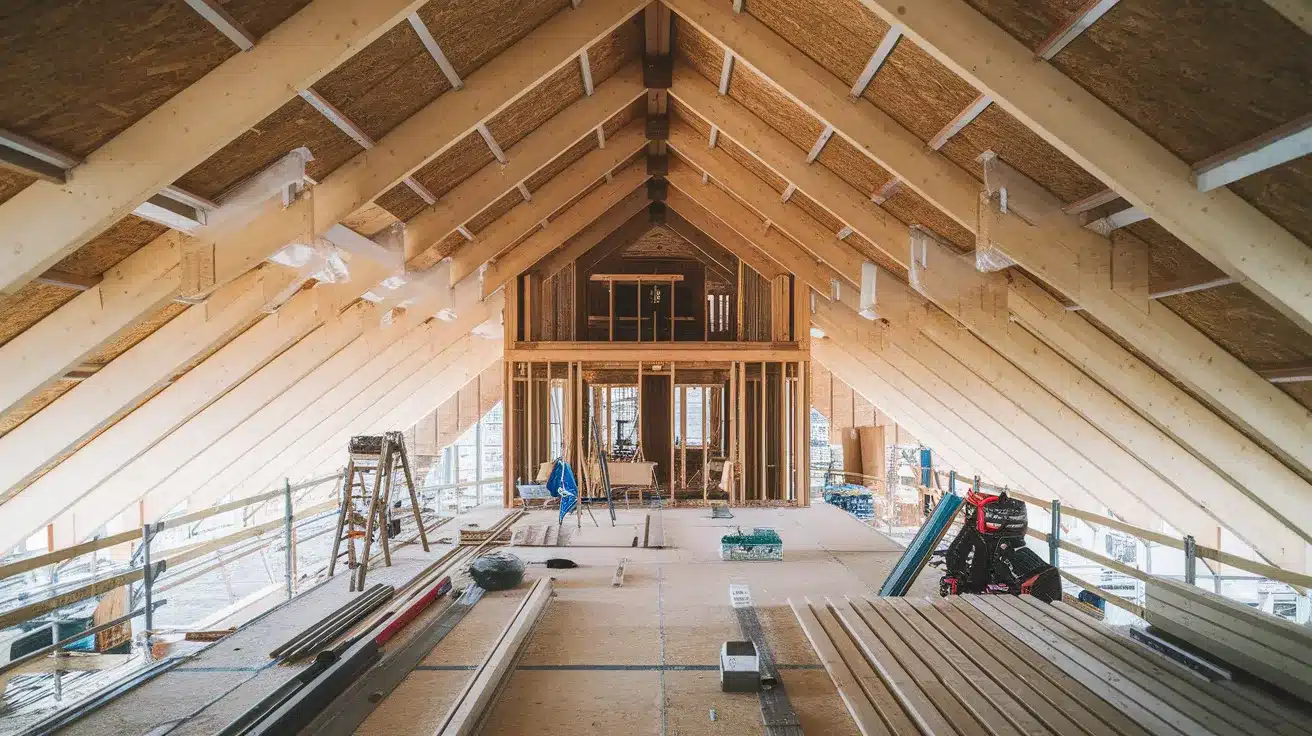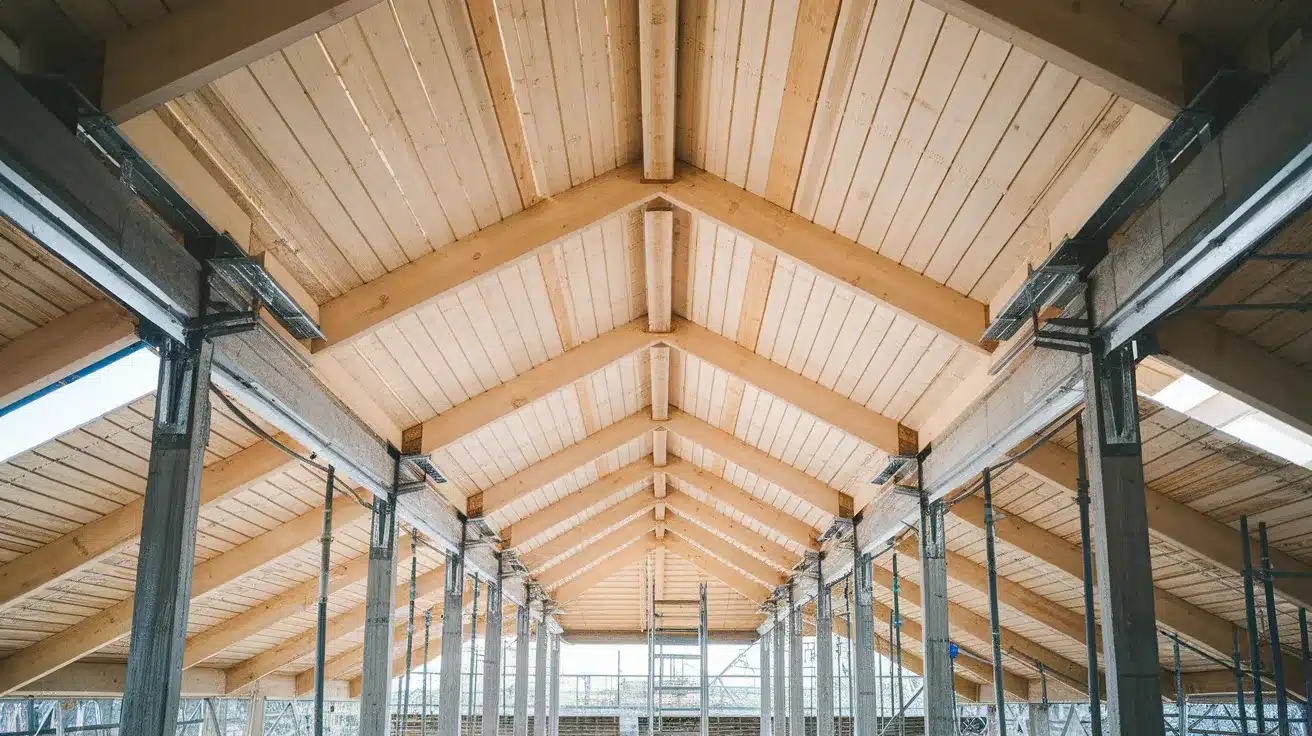Ever wondered what keeps your roof from falling apart during storms? The secret lies hidden beneath those shingles you see every day.
Most homeowners never think about roof sheathing until something goes wrong. But this invisible layer does all the heavy lifting. It holds your shingles in place, keeps water out, and even helps your house stay strong during bad weather.
Without proper sheathing, your roof would be like a puzzle missing half its pieces. The shingles would have nothing to grab onto, and your attic would flood with the first heavy rain. Your entire roof structure could fail.
So, what exactly is roof sheathing? How does it work? And why should you care about something you can’t even see?
Let’s pull back the layers and look at this hidden hero of your home’s protection system.
What Is Roof Sheathing?
Roof sheathing is the wooden layer that sits right under your shingles. Think of it as your roof’s backbone. This flat surface gives your shingles something solid to attach to. Without it, you’d just have bare rafters with gaps between them. Your shingles would sag and fall through those spaces.
Sheathing does three important jobs for your home:
- Adds strength – Connects all your roof rafters together, making your whole roof structure much stronger
- Prevents leaks – Creates a solid barrier between your home and the weather outside
- Holds everything together – All your roofing materials need this base layer to stay in place
Most builders use two main materials for sheathing:
- OSB (Oriented Strand Board) – Made from wood chips pressed together. It’s cheaper and works well for most homes
- Plywood – Made from thin wood layers glued together. It costs more but handles moisture better than OSB
Both materials do the same basic job. They give your roof the solid foundation it needs to protect your home from wind, rain, and snow. Without good sheathing, your roof would be weak and unreliable.
Types of Roof Sheathing
There are two main types of roof sheathing you’ll find on homes today. Each has its own pros and cons depending on your budget and climate.
Plank Sheathing is the old-school method that’s been around for decades. Builders used wooden planks like 1×6 or 1×8 boards laid across the rafters.
You’ll still see this type in older homes built before the 1950s. The planks run horizontally with small gaps between each board. This spacing was actually planned – it let the roof “breathe” and helped prevent moisture buildup.
Sheet Sheathing became the modern standard in the mid-1900s. Instead of individual boards, builders use large flat sheets that cover much more area at once.
These sheets create a solid, continuous surface with no gaps. This gives better protection from weather and provides a stronger base for your roofing materials.
Sheet sheathing comes in two main materials – OSB and plywood. Both work well, but they have different strengths:
| Feature | OSB (Oriented Strand Board) | Plywood |
|---|---|---|
| Cost | Lower price at $15-25 per sheet. Budget-friendly option for most homeowners. Great for keeping project costs down. | Higher cost at $25-40 per sheet. Premium choice that costs 30-50% more than OSB. Better long-term investment. |
| Weight | Lighter at 50-60 lbs per sheet. Easier for workers to carry up ladders and handle on rooftops. Less strain on installers. | Heavier at 60-75 lbs per sheet. Requires more effort and sometimes extra workers to install safely. Can slow down job progress. |
| Moisture Resistance | Swells up to 15% when wet. Takes 2-3 days to dry completely. Can stay puffy if it gets soaked repeatedly. Problems in humid climates. | Handles water much better. Swells only 2-5% when wet. Dries faster within 12-24 hours. Returns to original size better. |
| Strength | Good structural strength for standard homes. Meets building codes in most areas. Works fine for typical weather conditions. | 25% stronger than OSB. Better flex strength and impact resistance. Handles heavy snow loads and strong winds better. |
| Installation | Quick and easy installation. Standard tools work fine. Contractors can work faster. Cuts cleanly with circular saws. | Takes more skill to install properly. Requires sharper saw blades. More careful handling needed to prevent splits. |
| Lifespan | 15-20 years in dry climates. Only 10-15 years in wet areas. May need replacement sooner in coastal regions. | 25-30 years in most climates. Lasts 20-25 years even in humid areas. Better long-term durability overall. |
| Appearance | Rough texture with visible wood chips and strands. Shows manufacturing marks. Not smooth to touch. | Clean, smooth surface with natural wood grain patterns. Looks more finished and professional. |
| Best Uses | Standard homes in dry to moderate climates. Budget-conscious projects. Areas with low rainfall and humidity. | High-end homes. Wet climates with lots of rain. Areas with severe weather like hurricanes or heavy snow. |
Most contractors choose OSB for regular residential projects because it meets building codes and works fine in most climates. But plywood becomes the better choice in areas with heavy rainfall, high humidity, or extreme weather conditions. The extra cost pays off with better durability and moisture resistance.
Both materials need proper installation to work correctly. The sheets must be nailed down securely and the edges should be supported by rafters or blocking.
What Sheathing Actually Does?
Roof sheathing might be hidden from view, but it’s working hard every single day to protect your home. This wooden layer does much more than just hold up your shingles.
1. Supports All Your Roofing Materials
Sheathing gives every part of your roof system something solid to attach to. Your shingles need a flat, stable surface to lie on properly. Without sheathing, they would just fall through the gaps between your rafters.
The underlayment that goes under your shingles also needs this solid base. It can’t do its job of blocking water if it’s sagging between rafters. Gutters, flashing, and even satellite dishes all depend on having solid sheathing to anchor into safely.
2. Prevents Your Roof From Sagging
Over time, roofing materials get heavy. A typical roof carries thousands of pounds of shingles, plus snow, ice, and rain. Sheathing spreads this weight evenly across all your rafters instead of letting it concentrate in just a few spots.
Without sheathing, your rafters would have to carry all this weight by themselves. They would start to bow and sag under the load. This creates wavy, uneven rooflines that look bad and can cause bigger structural problems later.
3. Helps Stop Water Leaks
Good sheathing creates a continuous barrier across your entire roof surface. It blocks wind-driven rain from getting through small gaps in your shingles. Even if a few shingles get damaged in a storm, the sheathing underneath keeps water from pouring into your attic.
This backup protection is especially important around roof edges, valleys, and anywhere two roof sections meet. These spots see the most water flow during heavy rains. Solid sheathing gives you an extra layer of security in these vulnerable areas.
4. Adds Fire Resistance to Your Home
Most sheathing materials have some natural fire resistance. While they’re not fireproof, they do slow down flames and give you more time to get out safely. Thicker sheathing like plywood offers better fire protection than thinner materials.
This fire resistance becomes really important if sparks from wildfires or nearby buildings land on your roof. The sheathing can help prevent small fires from spreading quickly through your roof structure and into your living space below.
How Much Does Roof Sheathing Cost?
When planning a roof project, sheathing costs can catch homeowners off guard. Many people focus on shingle prices and forget about this important layer underneath. But sheathing material and installation make up a big part of your total roofing budget.
The final price depends on several factors. Your roof size matters most – bigger roofs need more materials and labor. The type of sheathing you choose also affects costs. And if you’re replacing old sheathing, removal and disposal add extra expenses.
| Cost Factor | OSB Sheathing | Plywood Sheathing |
|---|---|---|
| Material Cost Per Sheet | $15-25 (4×8 sheet) | $25-40 (4×8 sheet) |
| Coverage Per Sheet | 32 square feet | 32 square feet |
| Cost Per Square Foot | $0.50-0.80 | $0.80-1.25 |
| Labor Installation | $2-4 per sq ft | $2-4 per sq ft |
| Total Cost Per Sq Ft | $2.50-4.80 | $2.80-5.25 |
| Average 1,500 Sq Ft Roof | $3,750-7,200 | $4,200-7,875 |
| Average 2,000 Sq Ft Roof | $5,000-9,600 | $5,600-10,500 |
| Old Sheathing Removal | $1-2 per sq ft | $1-2 per sq ft |
| Disposal Fees | $300-600 total | $300-600 total |
| Complex Roof Shapes | Add 15-25% more | Add 15-25% more |
| High Pitch Roofs | Add 10-20% more | Add 10-20% more |
Most contractors charge between $2.50 and $5.25 per square foot for complete sheathing installation. This includes materials, labor, fasteners, and basic cleanup. OSB keeps costs lower while plywood offers better quality for more money.
Remember these prices can change based on your location and current lumber costs. Getting quotes from multiple contractors helps you find the best deal. Also ask if the price includes removing your old sheathing – this step can add $1,500-4,000 to your total project cost.
Benefits of Roof Sheathing
Roof sheathing provides several key advantages that make it essential for any quality roofing system. Here are the main benefits you get from proper sheathing installation:
- Structural Support – Connects all roof rafters together to create a strong, unified frame. Distributes weight evenly across the entire roof structure instead of putting stress on individual rafters.
- Weather Protection – Creates a solid barrier that blocks wind-driven rain and snow from entering through gaps. Provides backup protection if shingles get damaged during storms.
- Prevents Sagging – Keeps roofing materials flat and properly aligned over time. Stops heavy loads like snow and ice from causing rafters to bow or bend under pressure.
- Better Installation Base – Gives contractors a stable, even surface to install shingles, underlayment, and other roofing materials. Makes the installation process faster and more reliable.
- Increased Home Value – Quality sheathing improves your roof’s lifespan and performance. Potential buyers see good sheathing as a sign of a well-built, maintained home that won’t need major roof work soon.
These benefits work together to protect your biggest investment – your home. Good sheathing might cost more upfront, but it saves money by preventing expensive repairs and extending your roof’s life. Most building codes now require proper sheathing because of these important advantages.
Conclusion
Your roof sheathing works 24/7 to keep your family safe and dry. This wooden foundation layer might seem simple, but it handles some big responsibilities.
From supporting heavy snow loads to blocking water during storms, sheathing proves its worth every day. It connects your rafters into one strong unit. It gives your shingles a solid base to grip onto. And it provides that crucial backup protection when weather gets rough.
The choice between OSB and plywood comes down to your budget and climate. Both materials do the job well when installed correctly. OSB saves money upfront while plywood offers better long-term durability.
Don’t let contractors cut corners on sheathing quality. Good materials and proper installation pay off with fewer repairs and longer roof life. Your sheathing investment protects everything else in your home.
Next time you look at your roof, you’ll know there’s more going on than meets the eye. That hidden wooden layer is your home’s first line of defense.



